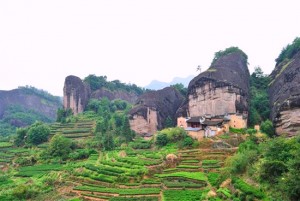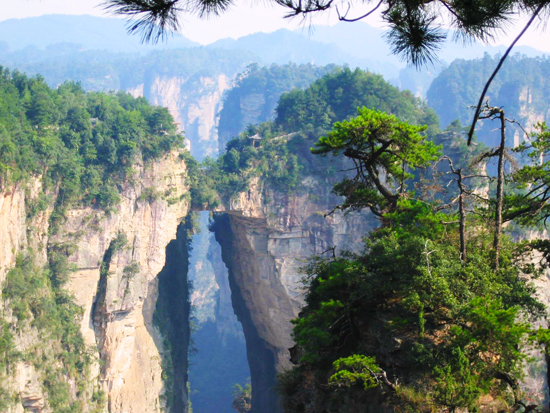The Wuyi Mountains are a mountain range located just to the south of Wuyishan City in Nanping Prefecture, Fujian. It rests on the border between Fujian and Jiangxi, and its highest peak, Mount Huanggang, is the highest point of both provinces. The range boasts altitudes of 200 metres (660 ft.) at its lowest to over 2,100 metres (7,000 ft.) at its highest! Yet tall, dark, and handsome though these mountains may be, their true value lies in their cultural, scenic, and natural importance. In fact, this range has played such a significant role in Chinese history that UNESCO listed it as a World Heritage Site in 1999.
The range is characterised by rushing waters, deep river valleys, columnar cliffs, and complex cave systems. In the western portion, the peaks typically consist of volcanic rock, while in the eastern area they are mainly made up of red sandstone with steep slopes and flat tops. This creates a myriad of landscapes, from sheer white cliffs to rusty red plinths. The mountains form a protective barrier against the northwesterly winds and, as a result, the climate within the range is humid with a high level of rainfall and plenty of condensation. Watching the peaks rise mistily out of the fog is truly breath-taking, that is if you can see through all the sweat on your face!
The range represents some of the finest examples of both Chinese subtropical forests and South Chinese rainforests. These habitats support a rich ecology and biodiversity that has thrived since the Ice Age over 3 million years ago. From evergreen broad-leaved forests to bamboo forests and meadow steppes, the plethora of greenery will not leaf you wanting more! In fact, these diverse environments house over 3,500 species of plant, 4,500 species of insect, and 450 species of vertebrates.
These include 49 species that are endemic to China and 3 that are endemic specifically to the Wuyi Mountains, such as David’s parrotbill and Pope’s spiny toad. Just watch your step; Clifford H. Pope named that toad for a reason! Numerous endangered species, including clouded leopards and South Chinese tigers, all prowl the expanse of these mountains. Yet by far the most revered and feared members of the Wuyi community are its snakes. From King cobras and bamboo vipers to 33-foot-long pythons, these slithery serpents have been worshipped, eaten, and used in medicine by the locals for hundreds of years. Steak and chips? Why not try snake and chips?
Archaeological evidence indicates that the Wuyi Mountain region was occupied by humans before the Xia Dynasty (c. 2100-1600 BC) but was not consolidated into the Chinese empire until the Han Dynasty (206 BC–220 AD). In the 1st century BC, a large administrative town named Chengcun was established there and, during the 7th century, the royal Wuyi Palace was built nearby.
It was then that Wuyi achieved its status as a sacred mountain. It became the first centre for Taoism in the region and many Taoist temples and academies were founded here, until Taoism was superseded by Buddhism in the 17th century. By the Tang Dynasty (618-907), the mountain had become such a holy spot that Emperor Xuanzong issued a decree forbidding fishing and logging in the area; a decree which is still active today. So if you’re hankering for some fish fingers, you’ll need to look elsewhere!
 During the Song Dynasty (960-1279) it reached the height, or should I say peak, of its cultural importance as it became the cradle for the revolutionary school of thought known as Neo-Confucianism. In 1183, scholar Zhu Xi established the famous Wuyi Jingshe Academy on the mountain range and began developing the doctrines that would evolve into Neo-Confucianism. This school of thought is considered to be the most influential of its kind throughout the whole of the Far East.
During the Song Dynasty (960-1279) it reached the height, or should I say peak, of its cultural importance as it became the cradle for the revolutionary school of thought known as Neo-Confucianism. In 1183, scholar Zhu Xi established the famous Wuyi Jingshe Academy on the mountain range and began developing the doctrines that would evolve into Neo-Confucianism. This school of thought is considered to be the most influential of its kind throughout the whole of the Far East.
From the 11th to the 16th century there was an imperial tea farm here, which produced tea solely for the imperial court. Tea cultivation has become a main source of income for the Wuyi locals and, of the many types of tea grown here, the four most famous are: Big Red Robe, Iron Arhat, White Cockscomb, and Golden Turtle Tea. The mother bushes of all these teas can be found on this mountain range and tea from one of only three Big Red Robe mother bushes is so valuable that, in some instances, it can sell for up to $1,025,000 a kilogram (approximately £657,000)!
Nowadays, the incredible history of these mountains can be witnessed in the 18 wooden boat coffins sheltered on its steep cliffs that date back to the Shang Dynasty (c. 1600-1046 BC); the remains of 35 ancient academies that were built from the Song to the Qing (1644-1912) dynasties; and the 60 Taoist temples and monasteries that are littered throughout the range in varying degrees of ruin. Only four administrative buildings of the ancient city of Chengcun remain and the ruins of the Wuyi Palace have now been incorporated into a sort of living museum.
The Nine-Bend River meanders through a deep gorge in the centre of the range and is a staggering 60 kilometres (37 miles) in length. A bamboo raft ride down the river rewards any visitor with stunning views of the surrounding peaks and historical ruins that make this mountain so precious. However, if you’re feeling a little seasick, you may want to try hiking along the mountains instead! Other areas of scenic value include the celebrated Jade Maiden Peak, Water Curtain Cave, Heavenly Tour Peak, and Roaring Tiger Peak.
Impression Da Hong Pao is a 60 minute show that was masterminded by Zhang Yimou, the director behind House of Flying Daggers and similar shows such as Impression Liu Sanjie in Guangxi and Impression Lijiang in Yunnan. It is a stunning lightshow that uses the Wuyi Mountains as its natural backdrop and incorporates hundreds of local actors.
